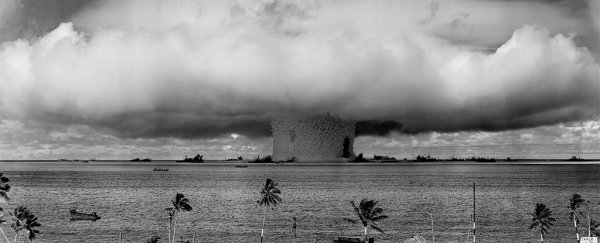If you want to know how far radioactive particles can travel, here's the answer: all the way to the Mariana Trench, which at 10,994 metres (36,070 ft) is the deepest natural trench in the world.
A new study shows that radioactive carbon from Cold War nuclear bomb tests is still present in the crustaceans living in the Mariana Trench, as well as other ultra-deep parts of the ocean.
And the researchers behind the work say it's the marine food chain that makes this radioactive carbon travel so far, so fast. It was detected at abnormally high levels in amphipods in the Mariana, Mussau, and New Britain trenches.
"Although the oceanic circulation takes hundreds of years to bring water containing bomb [carbon] to the deepest trench, the food chain achieves this much faster," says one of the team, geochemist Ning Wang from the Chinese Academy of Sciences in China.
Wang and his colleagues were looking for carbon-14, the radioactive carbon naturally formed when cosmic rays interact with nitrogen in the atmosphere.
The nuclear tests of the 1950s and 1960s led to a doubling of the carbon-14 in the atmosphere, as neutrons released by the bombs reacted with nitrogen. By the 1990s, that level of carbon-14 had dropped to 20 percent above pre-test levels, but this latest study shows the 'bomb carbon' still present deep underwater.
But there's another aspect to this research too: the way that this radioactive carbon might be helping life survive at great depths under the water, something which scientists are continuing to puzzle over.
In fact, marine organisms can use carbon-14 to build molecules within cells – it's another way they're able to survive at great depths, under intense pressure, at freezing temperatures, and without much to snack on.
The researchers say those intense circumstances might be the reason why crustaceans living in these trenches grow larger and live longer than similar creatures in shallower waters. The deep water amphipods can live up to 10 years, the researchers estimate, or five times as long as those in shallow water.
By comparing carbon-14 levels in the amphipods' guts and muscles with levels in the surrounding water and at the surface, it would appear the tiny critters are selectively feeding on matter that falls all the way down from the surface.
In other words, carbon spikes caused by human activity can still have a knock-on effect on marine life more than 60 years later, even at the deepest points of the ocean – and we're not sure yet exactly how that effect is playing out.
"There's a very strong interaction between the surface and the bottom, in terms of biologic systems, and human activities can affect the biosystems even down to 11,000 metres, so we need to be careful about our future behaviours," says one of the researchers, Weidong Sun from the Chinese Academy of Sciences.
"It's not expected, but it's understandable, because it's controlled by the food chain."
The research has been published in Geophysical Research Letters.
